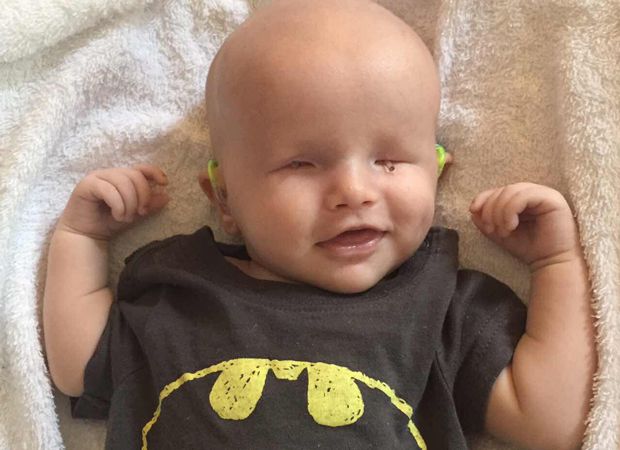Living With Bilateral Anophthalmia: Challenges And Opportunities For Children Born Without Eyes

Table of Contents
Understanding Bilateral Anophthalmia and its Impact on Development
Bilateral anophthalmia significantly alters sensory input, impacting various developmental aspects. However, children with this condition often demonstrate remarkable adaptability and resilience.
Sensory Development and Compensation
Children born without eyes rely heavily on their other senses. This often leads to heightened awareness and sensitivity in hearing, touch, smell, and even taste.
- Enhanced Sensory Processing: They may exhibit exceptional abilities to discern sounds, textures, and smells, compensating for the lack of visual input.
- Stimulating Other Senses: Engaging activities like playing with textured toys, listening to diverse soundscapes, and exploring aromatic materials can stimulate their sensory development.
- Sensory Integration Challenges: While enhanced senses are beneficial, integrating this sensory information efficiently can pose challenges, potentially requiring specialized sensory integration therapy.
Motor Skill Development and Physical Challenges
The absence of vision can impact the acquisition of motor skills. Crawling, walking, and grasping objects might require more time and specialized support.
- Adaptive Strategies: Parents and therapists can use verbal cues, tactile guidance, and adaptive equipment to assist with motor skill development.
- Early Intervention: Early intervention programs are crucial to support the child's physical development, preventing delays and promoting independence.
- Assistive Devices: Assistive devices such as adapted walkers, specialized toys, and tactile maps can aid in navigating their environment and developing motor skills.
Cognitive and Language Development
While cognitive development isn't directly linked to vision, the absence of visual input can influence how children learn and interact with the world.
- Stimulating Language Development: Engaging in interactive storytelling, singing, and descriptive language can foster language acquisition.
- Effective Teaching Methods: Multi-sensory learning approaches, incorporating tactile and auditory elements, are particularly effective.
- Areas of Support: Early intervention programs and specialized educators can provide targeted support to address any cognitive or language delays.
Addressing the Emotional and Social Well-being of Children with Bilateral Anophthalmia
Addressing the emotional and social well-being of a child with bilateral anophthalmia is crucial for their overall development and happiness.
Building Self-Esteem and Confidence
Fostering a positive self-image is paramount. Children need to understand their strengths and capabilities, independent of their visual impairment.
- Positive Reinforcement: Consistent positive reinforcement and encouragement of their abilities are vital for building confidence.
- Peer Support Groups: Connecting with other children facing similar challenges provides valuable social support and a sense of belonging.
- Role Models: Exposure to successful adults with anophthalmia can inspire and motivate children.
Social Integration and Peer Relationships
Social inclusion requires proactive efforts to educate peers and create supportive environments.
- Educating Peers: Openly discussing anophthalmia with peers helps dispel misconceptions and promotes understanding.
- Inclusive Environments: Creating inclusive environments in schools and communities ensures children feel accepted and valued.
- Advocacy for Accessibility: Advocating for accessible spaces and resources ensures children can participate fully in all aspects of life.
Parental Support and Coping Mechanisms
Parenting a child with bilateral anophthalmia presents unique challenges. Access to support and resources is essential for parents.
- Support Groups for Parents: Connecting with other parents of children with anophthalmia provides a valuable outlet for sharing experiences and coping strategies.
- Coping with Emotional Challenges: Seeking professional counseling can help parents manage emotional challenges and provide guidance in raising their child.
- Accessing Professional Counseling: Mental health professionals specializing in supporting families of children with disabilities can provide valuable tools and support.
Technological Advancements and Assistive Devices for Children with Bilateral Anophthalmia
Technological advancements are revolutionizing the lives of children with bilateral anophthalmia, enhancing their independence and sensory experiences.
Assistive Listening Devices and Sensory Aids
Technology plays a vital role in compensating for the lack of sight.
- Assistive Listening Devices: Amplified sound systems and directional microphones enhance hearing and improve auditory awareness.
- Tactile Learning Tools: Textured books, braille materials, and tactile maps provide alternative ways to access information.
- Sensory Integration Therapy: Technology-assisted sensory integration therapy can help improve sensory processing skills.
Mobility Aids and Orientation Tools
Technology assists in navigation and independent mobility.
- GPS Devices: GPS devices and apps provide location awareness and route guidance.
- Cane Training: Cane training provides safe and independent mobility.
- Orientation and Mobility Specialists: Specialized training from orientation and mobility specialists is invaluable for developing effective navigation strategies.
Communication Technologies
Technology expands communication options.
- Augmentative and Alternative Communication (AAC) Devices: AAC devices offer alternative ways to express thoughts and needs.
- Screen Readers: Screen readers allow access to digital information.
Accessing Resources and Support for Families Affected by Bilateral Anophthalmia
Finding appropriate support and resources is crucial for families.
Finding Support Groups and Organizations
Several organizations provide support and resources for families of children with anophthalmia.
- [Insert links to relevant organizations and support groups here]
Accessing Specialized Medical and Therapeutic Services
Early intervention and ongoing support are crucial.
- Ophthalmologists: While not directly treating anophthalmia, ophthalmologists can provide necessary eye health care.
- Optometrists: Optometrists can address any related vision issues, such as nystagmus.
- Therapists: Occupational therapists, physical therapists, and speech therapists play critical roles in supporting development.
- Educators: Specialized educators can tailor educational approaches to meet individual needs.
Conclusion
Living with bilateral anophthalmia presents unique challenges, but with appropriate support and resources, children can thrive. Early intervention, comprehensive therapy, and access to assistive technologies are crucial. Fostering a positive self-image and promoting social inclusion are paramount. By understanding the needs of these children and advocating for their well-being, we can empower them to reach their full potential. Learn more about bilateral anophthalmia, find support groups, and advocate for inclusive environments for all children. Remember, the absence of sight does not limit a child's ability to live a full and meaningful life. Let's work together to create a supportive world where children with bilateral anophthalmia can flourish.

Featured Posts
-
 Semana Santa O Semana De Turismo La Historia Detras Del Nombre En Uruguay
May 11, 2025
Semana Santa O Semana De Turismo La Historia Detras Del Nombre En Uruguay
May 11, 2025 -
 Next Season In Focus Stevenson And Ipswich Town
May 11, 2025
Next Season In Focus Stevenson And Ipswich Town
May 11, 2025 -
 Payton Pritchards Game 1 Performance A Turning Point For The Boston Celtics
May 11, 2025
Payton Pritchards Game 1 Performance A Turning Point For The Boston Celtics
May 11, 2025 -
 The Truth Behind Selena Gomez And Benny Blancos Alleged Baby Plans
May 11, 2025
The Truth Behind Selena Gomez And Benny Blancos Alleged Baby Plans
May 11, 2025 -
 The Truth Behind Henry Cavills Changing Beard In Mission Impossible Fallout
May 11, 2025
The Truth Behind Henry Cavills Changing Beard In Mission Impossible Fallout
May 11, 2025
